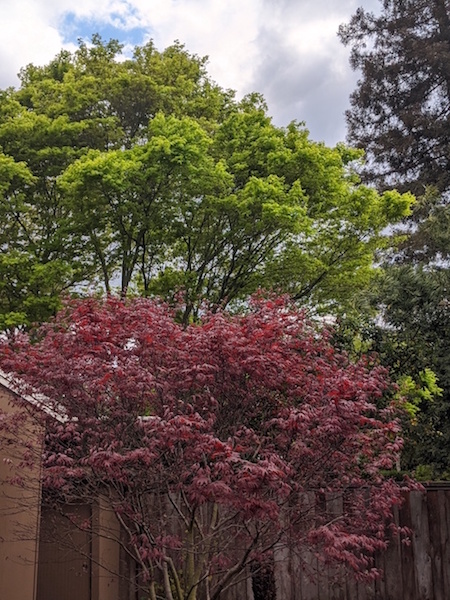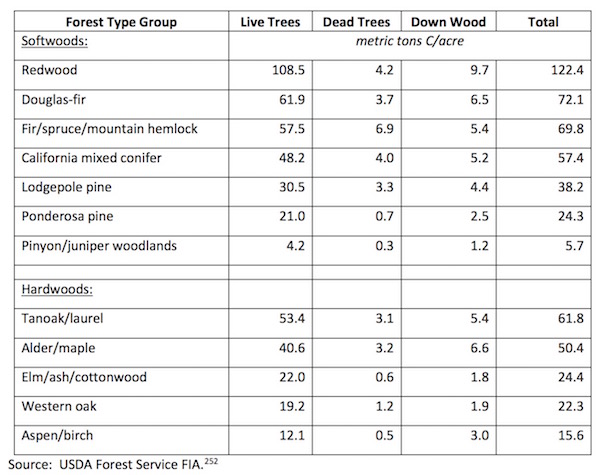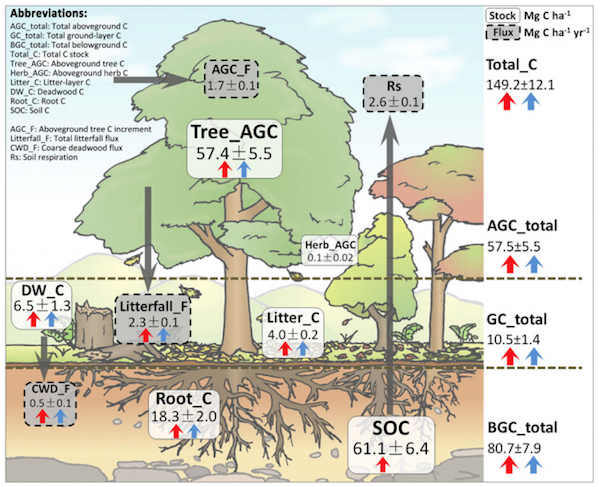
Photo by Barry Tao. A large ash tree in his backyard.
Last summer, a paper came out in Science extolling the potential ability of trees to remove carbon from the atmosphere. The researchers used Google Earth to look at tree coverage in micro-plots all over the world, then combined that with local data about climate, soils, and more to create a model of tree cover for the world. From this they created “the first ever quantitative, spatially explicit map of the Earth’s tree carrying capacity.” They found that we could have more trees on about 2.1 billion additional hectares, with the additional forest being able to absorb about two-thirds of the carbon dioxide we have emitted into the atmosphere. (1) They concluded: “This highlights global tree restoration as our most effective climate change solution to date.”

This map indicates where scientists in Zurich conclude we can grow more tree canopy (source: Crowther Lab)
Reaction was swift and bipolar. Leaders from across industry and government recognized the universal appeal of trees and were enthusiastic about the opportunity to offset emissions and finance the expansion of our much-loved forests. At January’s World Economic Forum, everyone from Prince Charles to Donald Trump touted the benefits of trees and committed to the new Trillion Tree initiative.

Photo by Hong-Ha Vuong. Taken in Foothills Park during an “escape from cabin fever”.
On the other hand, climate scientists and others criticized what they said were significant oversights in the paper and cautioned against putting too much emphasis on trees. The main criticisms they made were as follows:
1. Placement. The authors were likely too optimistic about where we want to plant trees. For example, covering grasslands and savannahs with trees would disrupt established, highly biodiverse ecosystems.
2. Impact. The authors neglected to account for the effects of reduced albedo (reflectivity of the Earth) from planting (dark) trees in light-colored areas. They also neglected to account for the carbon storage in the existing vegetation and soil. Some guessed that the researchers over-estimated by a factor of 2-4 how much additional carbon would be stored, and noted that the previous IPCC report had an estimate of just one-fourth the carbon storage from trees.
3. Efficiency. Trees do not permanently store carbon. Within a few hundred years they decay and release much of it back into the atmosphere. Furthermore, releasing carbon only to have trees capture and store it is much less efficient than simply not releasing the carbon to begin with.
The authors acknowledged many of these limitations, but in some cases said the issues were out of scope (e.g., change in albedo). They did in the end change their conclusion to “This highlights global tree restoration as one of the most effective carbon drawdown solutions to date.”
Indeed, forests today absorb almost 30% of the carbon dioxide in the atmosphere, and there is general agreement that we can and should do more with this natural asset. Today forests receive only about 2% of the funding for climate mitigation, according to Rebecca Shaw, Chief Scientist and Senior Vice President, World Wildlife Fund. Clearly we can do better.

Photo by Carolyn Tuomy. Taken at Gamble Gardens.
The Stanford Woods Institute for the Environment recently held an informative panel discussion on how we can make better use of the natural carbon “sink” that we have in forests. The panelists took an optimistic but pragmatic approach, which I will try to summarize here.
Options beyond planting new trees. There are many ways to store more carbon in our forests, and planting new trees is not always the best approach. Protecting existing forests, especially in the tropics, will have a bigger impact for less cost. These forests not only store large amounts of CO2, they also come with many co-benefits, including wildlife habitat, water recycling, soil fertilization, and more. We can also make better use of our existing forests. Ann Bartuska, Senior Advisor to Resources for the Future, has decades of experience with forest management in the US, from private stands in the southeast to public forests in the west. She says forest management can reduce insects and disease, improve resilience to fire, and foster older and larger trees. Restoring degraded lands, for example in areas where strip-mining took place, can be efficient because “nature does most of the work”. She also emphasizes the role of working forests, in which local communities can earn a living by harvesting lumber. The most costly approach is creating forests where we have not traditionally had forests. Shaw says “It is by far the most expensive and has many more barriers.” She emphasizes the need to develop and share information about species selection and placement, options for local incentives, and more, to ensure that the sizable investments in new forests “maintain their value over time”.

Photo by Janine Hodgson. A large tree in the early morning light.
Local buy-in. The panelists emphasized how important it is to ensure that locals are enthusiastic about forestry projects in their community, whether they are protecting existing forests or creating new ones. Daniel Nepstad, Executive Director and Senior Scientist, Earth Innovation Institute, has spent many years understanding how to preserve forests in developing countries. He listed a number of techniques that are proven to work, such as establishing baselines, monitoring, and reporting. But most critical of all is that we create sufficient value for the local populations. Nepstad gave an example in which preserving a forest saves $50,000 in avoided economic damages, but the farmer who owns the land is offered just $100 for maintaining the forest versus $1000 he may be paid for using it for agriculture. We need to “narrow the gap between $100 and $1000 to achieve the $50,000 benefit”. Nepstad also emphasizes the importance of listening and meeting the farmers where they are. “We need to be extremely pragmatic,” he urges. As an example, “There’s a lot of resistance to palm oil today. And yet it is the most productive, at scale at least, supplier of biodiesel and oil. It also has a lot of benefits for small holders. The small holders we talk to like having a small grove of palm oil because it’s a monthly income. So I think some of the more extreme views, we have to come together and have a pragmatic approach to optimizing entire landscapes and looking at the appropriate uses of the land.” As Chris Field, the Perry L. McCarty Director of Stanford Woods Institute for the Environment put it, “This really is about protecting livelihoods as well as protecting ecosystems.”

Photos by Al Ward and Karthik Hariharan. Redbuds in bloom.
Saving money. As Nepstad mentions, investments in forests can pay off many times over in terms of avoided economic damages from global warming. But there are more immediate payoffs as well. The World Resources Institute (WRI) cites a report that trees in the US “already provide $6.8 billion in health benefits every year by filtering pollution from the air, on top of additional benefits from cleaner water, wildlife habitat and forest industries.” Many types of agroforestry — combining trees with crops — can save farmers money. For example, when crop trees are added to grazing land (a practice called “silviculture”), they can add a new income stream while also reducing heat stress for animals and improving the soil. Low-value lumber can be converted to high-value cross-laminated timber that can be used for constructing tall buildings. Trees in urban areas reduce the need for expensive air-conditioning in addition to their myriad health benefits.

Photo by Suman Rangaswamy. Backyard trees after the rains.
Good opportunities abound. For those with money to invest, like large institutions, the panel was quite optimistic. Bartuska mentioned two areas where investment would yield “immediate wins”. On the east coast, degraded landscapes such as strip-mined areas are “low-hanging fruit”, with big improvements ready to be made once funding is available. “The Appalachian Commission is looking not only at the economic health of that region of the country but also the human health and the opportunities for jobs.” In the west, in state and national parks, “We have more land that needs reforestation than the federal government can possibly pay for.” Private-public partnerships would enable more aggressive reforestation, particularly in watersheds, that would yield a host of benefits, including wildlife habitat and generally higher quality of landscape. Nepstad sees opportunities in many tropical regions, but cautioned that some of the countries (e.g., the Democratic Republic of Congo) can be “very risky places to do business”. He strongly advocates for a regional approach rather than a project-by-project approach, to better align public and private policies, to get all of the stakeholders at the table, and to handle issues like leakage (e.g., deforestation moving to a nearby area with weaker governance). He asks: “Will this tsunami of money that is looking for offsets be fragmented into projects, which have their role but tend to have higher transaction costs and be less good at dealing with leakage? Or will they go to regional, jurisdictional programs that are in my opinion far more robust?”

Photo by Liz Neumann. Coral bark Japanese maple planted in memory of her late son, Tim Luntzel.
Do it right. We need to be smart about how and where we invest in trees so that “trillion trees” is not an unhelpful distraction from more important issues. That starts with planting the right trees. In the 1970s mesquite was introduced in Kenya to vegetate drying areas. It was so well suited to the environment that it quickly became an invasive species, killing native plants, ruining pasture land, and blocking irrigation canals. We should not repeat that expensive and harmful mistake. We also need to be thoughtful about when we want a fast-growing monoculture (e.g., a tree like loblolly pine or eucalyptus), and when we want to plant a variety of species together for a more resilient and biodiverse forest. Trees also need to be suited for the evolving climate. Chris Field cautions: “One of the things I think is important for everyone to recognize is that when there are discussions about the consequences of a trillion trees, that means a trillion fully-grown trees, which not only means that you have to plant way more than that, but you need to take care of them for a century or even more. And that’s in the context of a changing climate, in the context of a risk of wildfire and disease, and in the context of other pressures on land use. So there is a very wide river to cross between the idea of planting a trillion trees and having the full carbon consequences of that.”

Photo by Philippe Alexis. Taken at Skyline Ridge Preserve.
Finally, the panelists were in strong agreement that while trees have many important benefits and serve a critical role in absorbing carbon dioxide, efforts to grow and enrich our forests cannot be a substitute for reducing our use of fossil fuels. To put some numbers on it, WRI estimates that in the US we could add the equivalent of about 60 billion trees by 2040. (2) That would remove about 540 tons of CO2 per year, or only about 10% of US emissions. To keep the global temperature increase to 1.5 – 2.0 °C, it is imperative, and urgent, that we reduce our reliance on fossil fuels. As Rob Jackson, the Michelle and Kevin Douglas Provostial Professor of Earth System Science at Stanford University puts it, we must not “allow a ‘trillion trees’ to become a crutch, or be seen as replacing fossil fuel action, because we need that most of all.” (3)
I hope you have enjoyed the photos, and that you will take in trees with extra appreciation during your time outdoors this week.

Photo by Loretta Green. A dogwood grown from a stem her mother sent from South Carolina. The tree is now 10 years old. Her mother is now 105.
Notes and References
0. I’d like to say a special thank you to Ann Bartuska and to Professor Field for their reviews of this blog post. And thank you as well to the photographers who shared their lovely pictures.
1. To add some more detail, the researchers found that about two-thirds of all land (8.7 billion hectares) can support forest, but about 37% of that is treeless today. A little less than half of that potential forest land is used for growing food, leaving 1.7 billion hectares on which we could grow trees. They estimate we could have about 0.9 billion hectares of additional canopy cover (some land, like grazing pastures, would have only sparse coverage). For context, 0.9 billion hectares is about 3 million square miles, or about the area of the 48 contiguous states.
2. Specifically, WRI estimates we could plant about 24 billion trees in eastern forests (half are “understocked”); 21 billion trees in areas that have been degraded by wildfire, disease, or development (particularly out west); 13 billion trees on pasture land (“silviculture”); 2 billion in other types of agroforestry (e.g., near crops); and 400 million in urban canopy.
3. The New York Times has a recent opinion piece by three environmental scientists expanding on this view.
4. The lab that conducted the research on the global potential for trees (Crowther Lab in Zurich) has a simplified overview of it here.
5. Carbon Brief has a terrific overview of the state of UK forests. The most recent review of carbon storage in California forests that I could find is here.
Current Climate Data (February 2020)
Global impacts, US impacts, CO2 metric, Climate dashboard (updated annually)
“California’s climate continues to show extreme unpredictability,” says DWR Director Karla Nemeth. “Over the last decade, California’s snowpack has been alternating between extremely wet and extremely dry,” says Sean de Guzman, chief of DWR’s Snow Survey and Water Supply Forecast Section. “In the past 10 years, we’ve seen three of our smallest snowpacks on record, but we’ve also seen three of our largest snowpacks on record.” (Source: California’s Department of Water Resources (DWR))
Comment Guidelines
I hope that your contributions will be an important part of this blog. To keep the discussion productive, please adhere to these guidelines, or your comment may be moderated:
- Avoid disrespectful, disparaging, snide, angry, or ad hominem comments.
- Stay fact-based and refer to reputable sources.
- Stay on topic.





